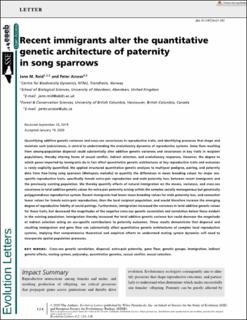| dc.description.abstract | Quantifying additive genetic variances and cross-sex covariances in reproductive traits, and identifying processes that shape and maintain such (co)variances, is central to understanding the evolutionary dynamics of reproductive systems. Gene flow resulting from among-population dispersal could substantially alter additive genetic variances and covariances in key traits in recipient populations, thereby altering forms of sexual conflict, indirect selection, and evolutionary responses. However, the degree to which genes imported by immigrants do in fact affect quantitative genetic architectures of key reproductive traits and outcomes is rarely explicitly quantified. We applied structured quantitative genetic analyses to multiyear pedigree, pairing, and paternity data from free-living song sparrows (Melospiza melodia) to quantify the differences in mean breeding values for major sex-specific reproductive traits, specifically female extra-pair reproduction and male paternity loss, between recent immigrants and the previously existing population. We thereby quantify effects of natural immigration on the means, variances, and cross-sex covariance in total additive genetic values for extra-pair paternity arising within the complex socially monogamous but genetically polygynandrous reproductive system. Recent immigrants had lower mean breeding values for male paternity loss, and somewhat lower values for female extra-pair reproduction, than the local recipient population, and would therefore increase the emerging degree of reproductive fidelity of social pairings. Furthermore, immigration increased the variances in total additive genetic values for these traits, but decreased the magnitudes of the negative cross-sex genetic covariation and correlation below those evident in the existing population. Immigration thereby increased the total additive genetic variance but could decrease the magnitude of indirect selection acting on sex-specific contributions to paternity outcomes. These results demonstrate that dispersal and resulting immigration and gene flow can substantially affect quantitative genetic architectures of complex local reproductive systems, implying that comprehensive theoretical and empirical efforts to understand mating system dynamics will need to incorporate spatial population processes. | en_US |

